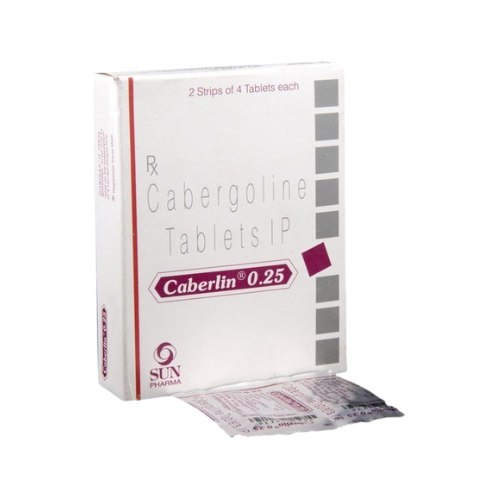Caberlin 0.25mg is a potent dopamine receptor agonist with a unique profile of clinical applications, primarily in the treatment of disorders associated with hyperprolactinemia. This article explores its mechanism of action, therapeutic uses, pharmacokinetics, side effects, and considerations for clinical practice.
Mechanism of Action
Caberlin 0.25mg exerts its effects primarily by stimulating dopamine D2 receptors. Dopamine is a neurotransmitter that, among other functions, inhibits the secretion of prolactin from the anterior pituitary gland. Prolactin is a hormone involved in various reproductive functions, including lactation. By activating D2 receptors, Caberlin 0.25mg effectively reduces the production and release of prolactin, thereby addressing conditions characterized by elevated prolactin levels.
In addition to its prolactin-lowering effects, Caberlin 0.25mg dopaminergic activity impacts other physiological processes, including motor control and behavior, making it relevant in the treatment of Parkinson’s disease, though this is a less common use.
Therapeutic Uses
1. Hyperprolactinemia
The primary clinical use of Caberlin 0.25mg is in the treatment of hyperprolactinemia, a condition characterized by elevated levels of prolactin in the blood. Hyperprolactinemia can result from various causes, including prolactin-secreting pituitary adenomas (prolactinomas), hypothyroidism, and certain medications.
Caberlin 0.25mg’s ability to reduce prolactin levels makes it an effective treatment for symptoms associated with hyperprolactinemia, such as:
- Galactorrhea (unintended milk production)
- Amenorrhea (absence of menstrual periods)
- Infertility
- Hypogonadism in men and women
2. Parkinson’s Disease
Although not a first-line treatment, Caberlin 0.25mg can be used in the management of Parkinson’s disease. Parkinson’s is a neurodegenerative disorder characterized by a loss of dopamine-producing neurons, leading to motor symptoms such as tremors, rigidity, and bradykinesia (slowness of movement). As a dopamine agonist, Caberlin 0.25mg can help alleviate these symptoms by compensating for the diminished dopamine activity in the brain.
3. Cushing’s Disease
Caberlin 0.25mg has also been investigated for the treatment of Cushing’s disease, a condition caused by excessive production of cortisol due to an ACTH-secreting pituitary tumor. Some studies suggest that Caberlin 0.25mg may reduce ACTH and cortisol levels, though its efficacy varies among patients.
4. Other Uses
Caberlin 0.25mg has been explored for other potential uses, including the treatment of acromegaly (a condition characterized by excessive growth hormone) and as an adjunct in fertility treatments. However, these uses are less well-established and often require further research to determine their efficacy and safety.
Pharmacokinetics
Caberlin 0.25mg is administered orally and has a long half-life, ranging from 63 to 69 hours, which allows for less frequent dosing compared to other treatments for hyperprolactinemia. This prolonged half-life is attributed to its strong binding affinity to dopamine receptors and slow elimination from the body.
After oral administration, Caberlin 0.25mg is absorbed from the gastrointestinal tract, reaching peak plasma concentrations within 2-3 hours. It undergoes extensive metabolism in the liver, primarily via hydrolysis, and its metabolites are excreted mainly in the feces, with a smaller proportion eliminated in the urine.
Side Effects
While Caberlin 0.25mg is generally well-tolerated, it can cause side effects, some of which may be significant. Common side effects include:
- Nausea and vomiting
- Dizziness or lightheadedness
- Headaches
- Fatigue
- Constipation
More serious side effects, though rare, can include:
- Cardiac valvulopathy: Prolonged use of Caberlin 0.25mg has been associated with the development of fibrotic changes in the heart valves, particularly at higher doses.
- Orthostatic hypotension: Sudden drops in blood pressure upon standing can occur, leading to dizziness or fainting.
- Psychiatric effects: Hallucinations, impulse control disorders, and other psychiatric symptoms have been reported, particularly at higher doses or in patients with Parkinson’s disease.
Considerations for Clinical Practice
When prescribing Caberlin 0.25mg, healthcare providers should consider several factors to ensure safe and effective use:
1. Baseline Evaluation and Monitoring
Before initiating Caberlin 0.25mg therapy, a thorough baseline evaluation is essential. This includes:
- Prolactin level measurement to confirm hyperprolactinemia
- Cardiac evaluation, including echocardiography, to rule out pre-existing valvular heart disease
- Assessment of liver function and renal function
During treatment, regular monitoring of prolactin levels is necessary to assess the effectiveness of therapy and adjust the dose as needed. Periodic cardiac evaluations are also recommended, especially for patients on long-term therapy.
2. Dosing and Administration
Caberlin 0.25mg is typically started at a low dose to minimize side effects, with gradual titration based on clinical response and tolerability. For hyperprolactinemia, the usual starting dose is 0.25 mg twice a week, with adjustments made every four weeks as needed. The dose for Parkinson’s disease may be higher, reflecting the different therapeutic targets.
3. Patient Education
Patients should be informed about the potential side effects of Caberlin 0.25mg and advised to report any unusual symptoms, particularly those related to cardiac function or psychiatric health. They should also be educated on the importance of adherence to the prescribed dosing schedule and the need for regular follow-up appointments for monitoring.
4. Drug Interactions
Caberlin 0.25mg may interact with other medications, particularly those affecting dopamine receptors or the cytochrome P450 system. Patients should be advised to inform their healthcare provider about all medications and supplements they are taking to avoid potential interactions.
Conclusion
Caberlin 0.25mg is a valuable medication in the management of hyperprolactinemia and other conditions associated with dopamine dysregulation. Its effectiveness, combined with a relatively favorable side effect profile, makes it a preferred choice for many patients. However, careful patient selection, thorough baseline evaluation, and regular monitoring are crucial to maximizing the benefits and minimizing the risks associated with Caberlin 0.25mg therapy. As with any medication, patient education and adherence to prescribed regimens are key components of successful treatment outcomes.





